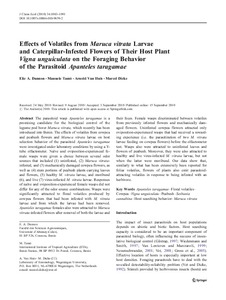| dc.contributor.author | Dannon, E.A. |
| dc.contributor.author | Tamò, M. |
| dc.contributor.author | Huis, A. van |
| dc.contributor.author | Dicke, M. |
| dc.date.accessioned | 2019-12-04T11:11:13Z |
| dc.date.available | 2019-12-04T11:11:13Z |
| dc.date.issued | 2010 |
| dc.identifier.citation | Dannon, E.A., Tamò, M., Van Huis, A. & Dicke, M.(2010). Effects of volatiles from Maruca vitrata larvae and caterpillar-infested flowers of their host plant Vigna unguiculata on the foraging behavior of the parasitoid Apanteles taragamae. Journal of chemical Ecology, 36(10), 1083-1091. |
| dc.identifier.issn | 0098-0331 |
| dc.identifier.uri | https://hdl.handle.net/20.500.12478/2381 |
| dc.description.abstract | The parasitoid wasp Apanteles taragamae is a promising candidate for the biological control of the legume pod borer Maruca vitrata, which recently has been introduced into Benin. The effects of volatiles from cowpea and pea bush flowers and Maruca vitrata larvae on host selection behavior of the parasitoid Apanteles taragamae were investigated under laboratory conditions by using a Y-tube olfactometer. Naïve and oviposition-experienced female wasps were given a choice between several odor sources that included (1) uninfested, (2) Maruca vitrata-infested, and (3) mechanically damaged cowpea flowers, as well as (4) stem portions of pea bush plants carrying leaves and flowers, (5) healthy M. vitrata larvae, and moribund (6), and live (7) virus-infected M. vitrata larvae. Responses of naïve and oviposition-experienced female wasps did not differ for any of the odor source combinations. Wasps were significantly attracted to floral volatiles produced by cowpea flowers that had been infested with M. vitrata larvae and from which the larvae had been removed. Apanteles taragamae females also were attracted to Maruca vitrata-infested flowers after removal of both the larvae and their feces. Female wasps discriminated between volatiles from previously infested flowers and mechanically damaged flowers. Uninfested cowpea flowers attracted only oviposition-experienced wasps that had received a rewarding experience (i.e. the parasitization of two M. vitrata larvae feeding on cowpea flowers) before the olfactometer test. Wasps also were attracted to uninfested leaves and flowers of pea bush. Moreover, they were also attracted to healthy and live virus-infected M. vitrata larvae, but not when the latter were moribund. Our data show that, similarly to what has been extensively been reported for foliar volatiles, flowers of plants also emit parasitoid-attracting volatiles in response to being infested with an herbivore |
| dc.description.sponsorship | Netherlands Universities Foundation for International Cooperation |
| dc.format.extent | 1083-1091 |
| dc.language.iso | en |
| dc.subject | Apanteles |
| dc.subject | Taragamae |
| dc.subject | Floral |
| dc.subject | Volatiles |
| dc.subject | Cowpeas |
| dc.subject | Vigna |
| dc.subject | Unguiculata |
| dc.subject | Peabush |
| dc.subject | Sesbania |
| dc.subject | Cannabina |
| dc.subject | Host |
| dc.subject | Searching |
| dc.subject | Behavior |
| dc.subject | Maruca |
| dc.subject | Vitrata |
| dc.title | Effects of volatiles from Maruca vitrata larvae and caterpillar infested flowers of their host plant Vigna unguiculata on the foraging behavior of the parasitoid Apanteles taragamae |
| dc.type | Journal Article |
| dc.description.version | Peer Review |
| cg.contributor.affiliation | Université d'Abomey Calavi |
| cg.contributor.affiliation | International Institute of Tropical Agriculture |
| cg.contributor.affiliation | Wageningen University and Research Centre |
| cg.coverage.region | Africa |
| cg.coverage.region | West Africa |
| cg.coverage.country | Nigeria |
| cg.isijournal | ISI Journal |
| cg.authorship.types | CGIAR and developing country institute |
| cg.iitasubject | Cowpea |
| cg.iitasubject | Grain Legumes |
| cg.journal | Journal of Chemistry Ecology |
| cg.howpublished | Formally Published |
| cg.accessibilitystatus | Limited Access |
| local.dspaceid | 92290 |
| cg.targetaudience | Scientists |
| cg.identifier.doi | https://dx.doi.org/10.1007/s10886-010-9859-2 |

